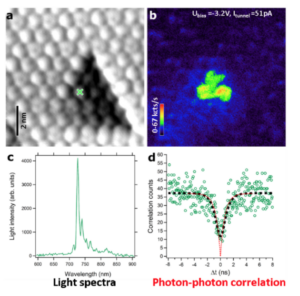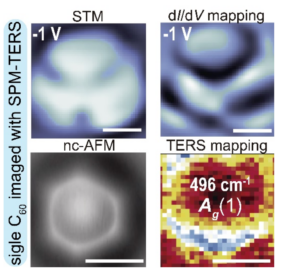When photons are focused on the apex of a metallic tip, the electromagnetic field is enhanced and localized within the small volume below the tip apex. The local enhancement enables efficient bidirectional near-to-far field conversion between free charge oscillations of the combined tip-sample system (nanocavity plasmons) and the electromagnetic field of the freely propagating photons. External light sources can be coupled to nanoscale systems and scattered light or emission from nanoscale systems can be collected by detectors far away from the nanocavity. The combination of sharp tips with light, is revolutionizing the understanding of many photophysical and photochemical phenomena at the nanoscale. Currently we are progressing in the long-term plan to implement and apply STM induced luminescence (STML) and tip-enhanced Raman scattering (TERS) in the ultrahigh vacuum VT-STM instrument. Accordingly, we have two sublines:
- Time resolved Scanning Tunneling Microscopy Luminescence (TR-STML)

We are deeply interested in energy conversion mechanism between charges and photons on the single molecule level. For this purpose, we combine atomic-scale scanning tunneling microscopy-induced luminescence (STML) with time resolved correlation spectroscopy achievable in light detection. Dynamical processes can be routinely accessed on the nanoscale with STM but achieving high temporal resolution below the millisecond range has remained a challenge. Light, in contrast, permits ultrafast dynamic studies of nanoscopic systems and can be employed to complement the analytical power of STM. Light can be easily detected at the single single-photon level, which permits to characterize dynamical processes in regimes that are not readily accessible by electronic means. This approach permits accessing the charge separation and recombination dynamics responsible for light emission and light absorption of individual quantum systems at surfaces.
Responsible Scientist:
Pablo Merino
- Tip enhanced Raman scattering (TERS) on low dimensional materials
 Chemical species can be identified through the detection of their rotational and rotovibrational transitions. Tip-enhanced Raman spectroscopy (TERS) is an incipient technique called to revolutionize our knowledge of vibrational modes of low dimensional systems. In Raman spectroscopy, an absorbed photon induces a dipole in the system, which then reradiates a photon in a scattering process. During this process, the induced dipole can transfer energy to a vibrational mode (Stokes scattering) or vice versa (anti-Stokes scattering) in the amount equal to one vibrational quantum, which is characteristic for every particular vibration. When STM junctions are used as optical hotspots (nanocavities), the large confinement of the electromagnetic field (EM enhancement) results in an exceptional Raman sensitivity and sub-A spatial resolution. Additionally, the observed Raman signal is modified by the interaction of the adsorbate with the underlying support (Chem enhancement), giving valuable information on the immediate chemical environment. Altogether, simultaneously accessing to the local electronic and vibrational distribution contributes to explore fundamental phenomena occurring at the interface between adsorbates and surfaces with unprecedented atomic precision, such as bond formation, charge transfer and energy injection/dissipation.
Chemical species can be identified through the detection of their rotational and rotovibrational transitions. Tip-enhanced Raman spectroscopy (TERS) is an incipient technique called to revolutionize our knowledge of vibrational modes of low dimensional systems. In Raman spectroscopy, an absorbed photon induces a dipole in the system, which then reradiates a photon in a scattering process. During this process, the induced dipole can transfer energy to a vibrational mode (Stokes scattering) or vice versa (anti-Stokes scattering) in the amount equal to one vibrational quantum, which is characteristic for every particular vibration. When STM junctions are used as optical hotspots (nanocavities), the large confinement of the electromagnetic field (EM enhancement) results in an exceptional Raman sensitivity and sub-A spatial resolution. Additionally, the observed Raman signal is modified by the interaction of the adsorbate with the underlying support (Chem enhancement), giving valuable information on the immediate chemical environment. Altogether, simultaneously accessing to the local electronic and vibrational distribution contributes to explore fundamental phenomena occurring at the interface between adsorbates and surfaces with unprecedented atomic precision, such as bond formation, charge transfer and energy injection/dissipation.
Responsible Scientist:
Borja Cirera

